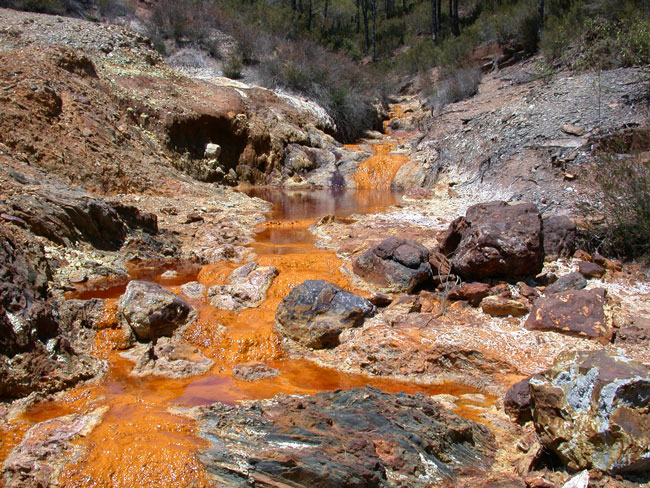As the industrial revolution surges forwards and the technological innovation continues.There is an increasing demand for raw materials such as iron,copper etc.These are mainly obtained from mining.Mining is the extraction of valuable minerals or other geological materials from the earth from an ore body, lode or seam which forms the mineralized package of economic interest to the miner.Mining of stone and metal has been done since per-historic times. Modern mining processes involve searching for ore bodies, analysis of the profit potential of a proposed mine, extraction of the desired materials, and final analysis of the land after the mine is closed.
The increasing industrial activities are putting a huge strain on the market for more and more Underground mining is often below the water table,as the water table tries to regain balance,it floods the mine,so water must be constantly pumped out of the mine in order to prevent flooding. When a mine is abandoned, the pumping ceases, and water floods the mine.This mixes with the metals present in the mine.Accelerated by the presence of bacteria which especially favor the low pH levels of abandoned mines.Such as Acidithiobacillus ferrooxidans.These bacteria break down the minerals which mix with the water and form acid solution to be formed.
The nature of mining processes creates a potential negative impact on the environment both during the mining operations and for years after the mine is closed.Metal mines may generate highly acidic discharges where the ore is a sulfide mineral or is associated with pyrite. In these cases the predominant metal may not be iron but rather zinc, copper, or nickel. The most commonly mined ore,chalcopyrite, is itself a copper-iron-sulfide and occurs with a range of other sulfides. Thus, copper mines are often major culprits of acid mine drainage.
In a mining setting it is leading practice to carry out a geochemical assessment of mine materials during the early stages of a project to determine the potential for AMD. The geochemical assessment aims to map the distribution and variability of key geochemical parameters, acid generating and element leaching characteristics.The assessment may include first sampling the space.Then carrying out the geochemical testwork.We conduct oxygen consumption tests, such as the OxCon, to quantify acidity generation rates.Modelling of oxidation, pollutant generation and release is calculated and permission to open mine is then granted.
Areas exposed to these acid mine drainage suffer immense environmental drainage.At some mines, acidic drainage is detected within 2–5 years after mining begins, whereas at other mines, it is not detected for several decades.In addition, acidic drainage may be generated for decades or centuries after it is first detected. For this reason, acid mine drainage is considered a serious long-term environmental problem associated with mining.
Releases of acid mine waters containing elevated metal and cyanide concentrations with resulting impacts to landscapes and waterways have been documented by several organizations. Fish kills resulting from the uncontrolled release of acid and metals from mine wastes into receiving streams have been reported from world wide areas in which hard rock mining, milling, and smelting activities have occurred.
The acid mine drainage can be prevented or treated.There are two primary approaches to addressing AMD, circumvent mining sulfide rich ore deposits with high AMD potential, and implementing mitigation measures to limit potential AMD impacts.Acid Mine drainage can be prevented, Every effort should be employed to minimize the causes of acid generation. Because mineralogy and other factors that influence AMD formation are highly variable from one mine to another, and among different geologic materials within a proposed mine site, accurate prediction of future acid generation is difficult at best. Predicting the potential for AMD formation is costly, and of questionable reliability. It is noted that avoiding mining of sulfide ores with the potential to form AMD may be difficult because they are most often associated with the mineral resource of interest.
.Acid Drainage can be treated.Water treatment for elevated metal levels and acidity is a common outcome of acid mine drainage. The effectiveness and feasibility of water treatment is highly variable depending on the treatments employed and unique site characteristics. Water treatment installations may include both passive and active systems. Passive water treatment systems, typically wetlands, operate without chemical amendments and without motorized or mechanized assistance. In contrast active water treatment systems are highly engineered water treatment facilities commonly employing chemical amendment of acid mine water to achieve a water quality standard specified in a discharge permit.This overall reduces the impact of acid mine drainage.
In summary,Acid mine drainage commonly forms as a result of natural geochemical processes that oxidize metal sulfides exposed at the earth’s surface by mining. Oxidation of sulfur and hydrolysis of iron result in acid-sulfate waters which have been observed at thousands of historic mine sites and at operational mines where mitigation measures have failed to prevent the release of acid mine drainage to down-gradient surface waters. Resultant low pH conditions mobilize metals from waste materials resulting in degradation of water quality and impairment of aquatic health.Evidence from literature and field observations suggests that permitting large scale surface mining in sulfide-hosted rock with the expectation that no degradation of surface water will result due to acid generation imparts a substantial and unquantifiable risk to water quality and fisheries.

Leave a Reply